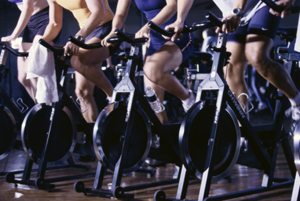Indoor Bike Trainers: A Brief Overview

For those of you who have been trying to figure out the distinction, indoor bike trainers are functionally comparable to stationary bikes; the main difference is that with an indoor bike trainer, you are simply attaching an external device to your regular bicycle rather than utilizing a totally separate piece of gym equipment. Indoor bike trainers are sometimes used by cyclists for warming up and cooling down before or after a race, but they are more often used by endurance athletes either out of preference or when weather conditions do not allow for outdoor riding.
There are two types of indoor bike trainers: roller and mechanical resistance. Each has its own advantages and disadvantages but all are typically an inexpensive and convenient alternative to a stationary bike. The best option for you will depend on several factors, include the type of cycling you practice, the extent of your need for a realistic feel, and other considerations.
For the uninitiated, here’s a quick look at the various types of indoor bike trainers on the market today:
Roller Trainers
Roller trainers are essentially a set of rollers on which you set your bike. You will need to practice for some time in order to learn how to stay upright, but the results can have a significant impact on your riding skills. Every movement while on rollers is amplified, meaning that you learn to control your body in a way that improves your form and keeps you safer on the road. In this way, roller trainers also provide you with a core muscle workout that will help you maintain balance and stability, as resistance is only offered when shifting down gears.
Once you have learned how to mount and sit on top of the roller trainer, it often becomes the top choice for an authentic cycling experience that is beneficial to both mountain bikers and road bikers, although mountain bikes need trainer tires before they can be used on rollers.
Mechanical Resistance Trainers
Mechanical resistance trainers feature a frame to support the rear wheel and keep it in a vertical position. A roller behind the rear wheel powers the resistance, usually offered through either a wind, magnetic, or fluid mechanism. To use a mechanical resistance trainer, it is necessary to substitute your regular bike tires for indoor trainer tires unless you choose a slightly more costly model that provides resistance to the rim and therefore will not wear down the tread on your road wheels.
Mechanical resistance trainers have a number of significant advantages, not least their ease of use. Even the most novice rider can begin a workout on a resistance trainer with no prior learning. Mechanical resistance trainers provide a safe workout for intervals, standing up, and sprints as they are very similar to stationary bikes with the main focus on power. As an added perk, many resistance trainers come with DVD systems that can be used to simulate riding, with the higher priced models featuring numerous resistance settings.
There are three main types of mechanical resistance trainer: wind, magnetic, and fluid.
Wind
With wind indoor bike trainers, as the user cycles, air blows onto the wheel, which powers a circular fan and produces resistance. Wind bike trainers are usually the least expensive and least prone to breakage of the resistance trainers, and they still provide an experience that is relatively like cycling on the road. The main disadvantages are that they make a lot of noise and do not provide as much resistance as other mechanical cycles.
Magnetic
Magnetic bike trainers are intended to provide a quieter resistance than is gained with wind resistance. They also have a magnetic unit that allows the user to set the resistance to a specific level.
Fluid
Fluid indoor bike trainers are the most complex of the three and are therefore more likely to suffer from damage. They incorporate some elements of the magnetic resistance trainer along with liquid resistance chambers for a quiet and realistic ride.

